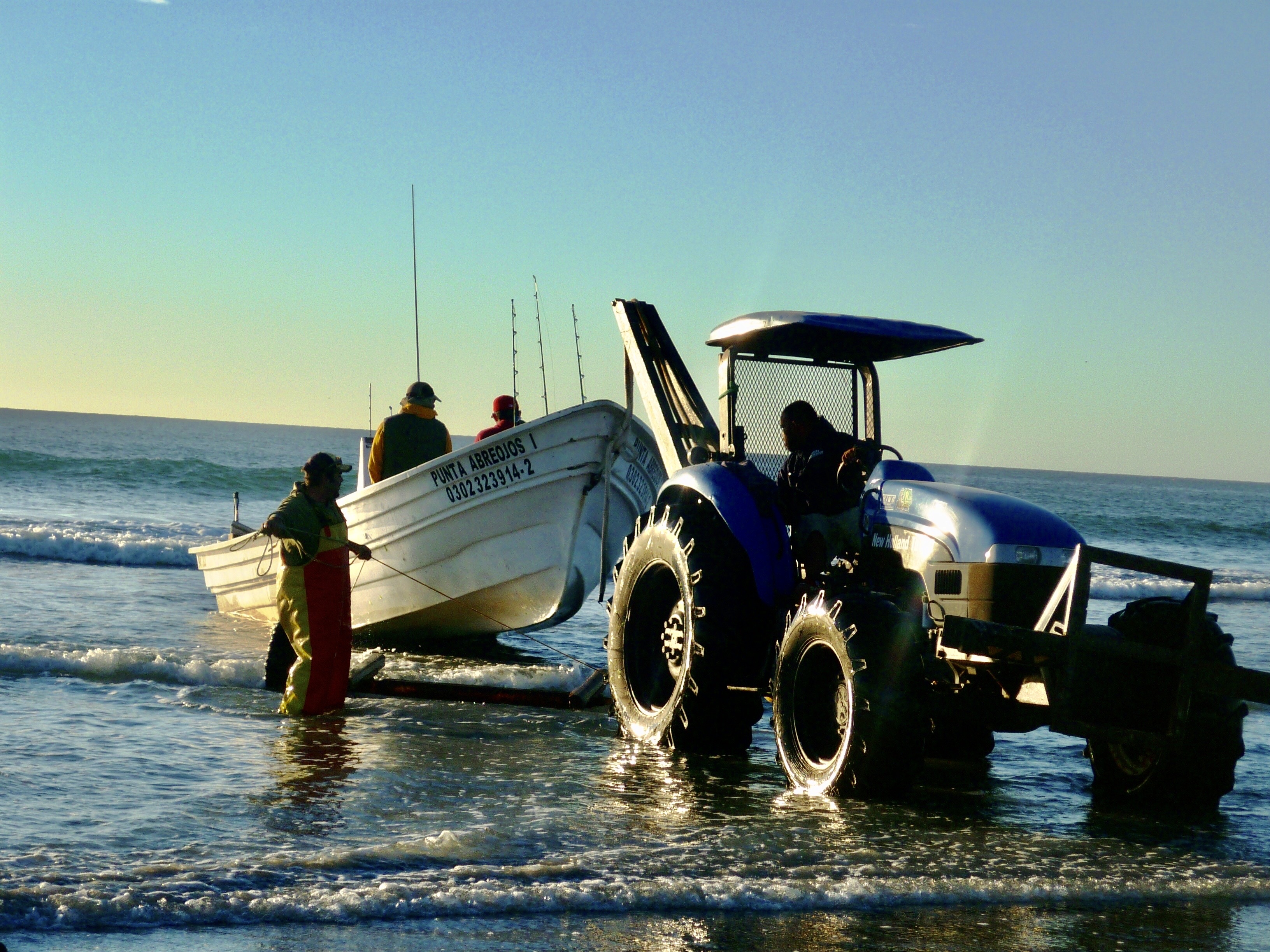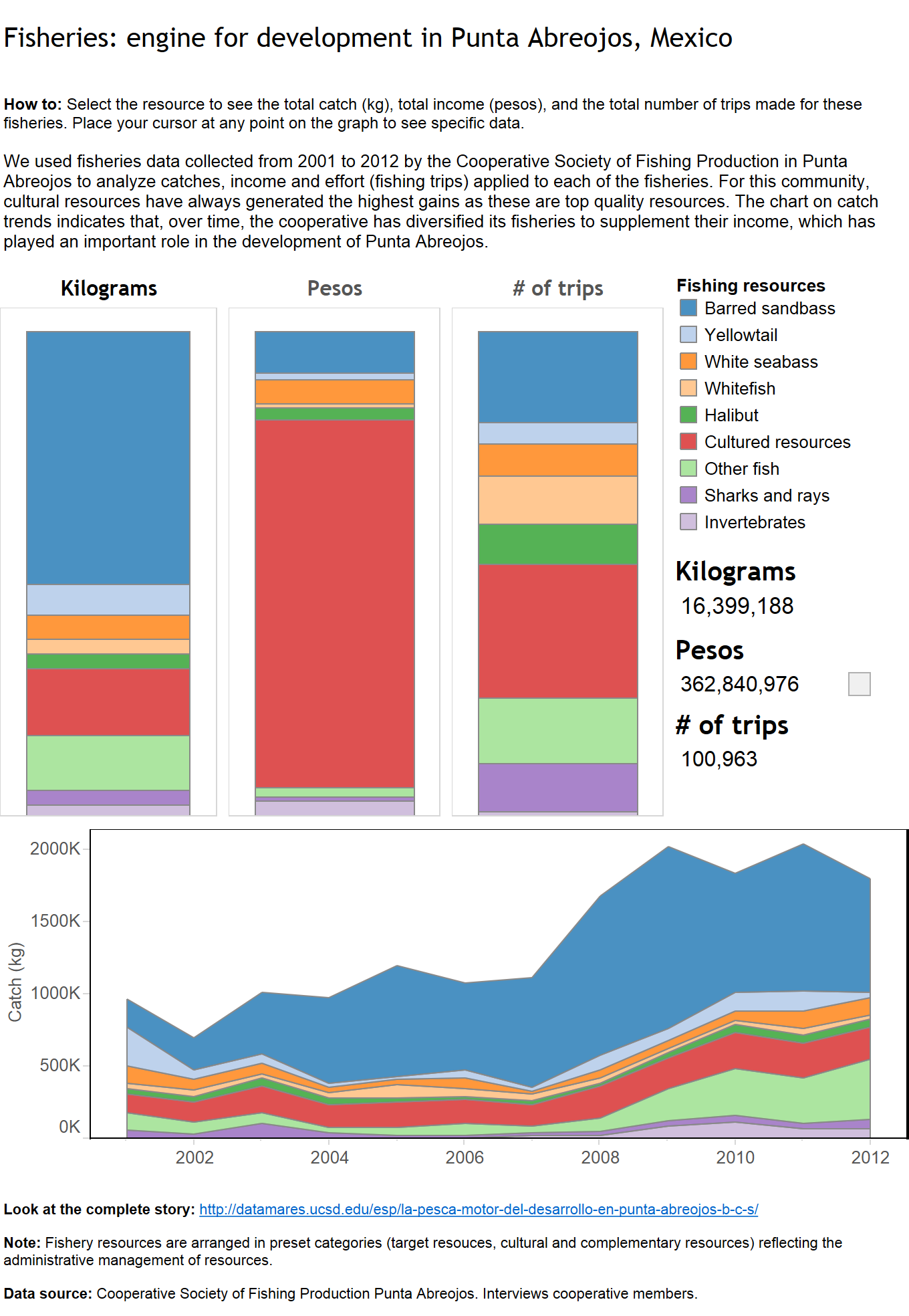Fisheries driving development in Punta Abreojos, Mexico.

Punta Abreojos is one of the most important fishing communities in terms of marine resource use and management in the North Pacific in Baja California Sur (1). This community, together with La Bocana, Bahia Asuncion, Bahia de Tortugas, and the rest that make up the Regional Federation of Cooperative Fishing Industry Societies of Baja California (FEDECOOP in Spanish), have improved in the management, production, and conservation of fisheries resources, and improved the socio-economic benefits that the fisheries provide (2).

The Cooperative Society of Fisheries Production in Punta Abreojos is a success story in fisheries management and sustainable development in the Mexican northwest. It has fishing concessions in an exclusive area, which covers 3,354 km2. For 73 years, the lobster (Panulirus interruptus) and the abalone (Haliotis fulgens and H. corrugata) have been the most important resources, economically speaking. Since the 1980s, the Cooperative began to diversify the fisheries, especially finfish (commercial fish), as a strategy to make up for the notable fall in abalone capture and at the same time to protect the lobster fishery.
Although catch volumes for these species are considerable, the changes in activities and catches need to be evaluated to create management strategies that benefit the Cooperative in the next few years without risking the the health of the fish population. With this objective in mind, we work with the Cooperative of Punta Abreojos to analyze the use patterns of 40 fisheries resources. According to interviews with leaders and members of the cooperative, we categorized these resources in three main groups: Cultural resources (lobster and abalone): pioneering fisheries that drove the development of the community; 2) Target resources (barred sandbass, yellowtail, white seabass, whitefish, and halibut): important resources because of their catch volumes and because they require a specific fishing method; 3) Complementary resources: (finfish, sharks and rays, invertebrates): species caught as by-catch or in smaller quantities.
Since 2000, the Cooperative in Punta Abreojos has a rigorous control of the information on fish catches with the help of software specially designed for them. With this software, the visualization and interpretation of the fisheries data has been faster and more efficient for the managers, which can help the commercialization of the products and the administration of the Cooperative. Through our collaboration with the Cooperative, we analyzed a database of fisheries records from 2001 to 2012, which included day, month, year, ship, resource, capture volume (kg), price per kilogram, and direct profit (pesos) for fisherman for catch volume.
Major findings
Cultural resources such as lobster (Panulirus interruptus and P. inflatus) and abalone (Haliotis fulgens and H. corrugata) play an important role in the economy of Punta Abreojos because they are resources with international demand and a high commercial value. They are exported to countries such as Singapore, China, Japan, USA, and France. Catch volumes for these resources have remained stable since strict management measures exist (concession, catch quotas, minimum catch sizes, international eco-certifications). Target and complementary resources, 18 species of finfish, eight species of elasmobranchs, and seven species of invertebrates, generate income to fishermen and the cooperative during the no-fishing periods for cultural resources.
Among the finfish species, the most important resource is the barred seabass (Paralabrax nebulifer), which can be captured and marketed throughout the year and is one of the predictable fisheries in Punta Abreojos (aggregation areas for breeding and feeding). The yellowtail (Seriola lalandi), the white seabass (Atractoscion nobilis), whitefish (Caulolatilus prínceps) and halibut (Paralichthys californicus and P. woolmani) are resources that, although they can be caught only certain months of the year, generate significant profits. For all resources included in the database, we can observe an increasing trend in catches from 2007 onwards.
Together, cultural, objective, and complementary resources make up a fishery dynamic guaranteeing financial profits throughout the entire year. Through these resources, the Cooperative generates sufficient capital to encourage and take care of their workers, people in the community, and former fishermen members (pensioners), as well as have a contingency fund (for emergencies).
Conclusions
Having updated fish databases helps to clearly describe the development of fisheries in a given site. These results represent a base line of direct gains for the fishermen of the Cooperative, helping the Cooperative of Punta Abreojos to manage their fishing activities and ensure responsible fishing in the long run. It also helps researchers understand the fishery dynamics in a location from a unique perspective. More importantly, this type of fisheries monitoring in places like Punta Abreojos, where fishing is the main source of jobs and income, is a tool so that the Cooperative can continue to work and enable the economic welfare of the whole community.
Authors:
J. José Cota-Nieto*, Brad Erisman**, Marcia Moreno-Baez*, Gustavo Hinojosa-Arango+ and Octavio Aburto-Oropeza±
Contact Information:
juan.jose@gocmarineprogram.org
DOI:
10.13022/M3NK51
Affiliations:
* Centro para la Biodiversidad Marina y la Conservación A.C., La Paz B.C.S.
** University of Texas Austin Marine Science Institute
+ Instituto Politécnico Nacional, CIIDIR Unidad Oaxaca
± Scripps Institution of Oceanography, UC San Diego
Acknowledgements:
We thank the Cooperative Society of Fishing Production of Punta Abreojos (Sociedad Cooperativa de Producción Pesquera Punta Abreojos S.C. de R.L.), as well as the fishermen of Punta Abreojos, the community team that participates in and supports the GCMP. Thank you to the Fondo Mexicano para la Conservación de la Naturaleza A.C., David & Lucile Packard Foundation, Walton Family Foundation and the Helmsley Trust Foundation.
How to cite this story:
J. José Cota-Nieto, Brad Erisman, Marcia Moreno-Baez, Gustavo Hinojosa-Arango, Octavio Aburto-Oropeza (2015): Fisheries driving development in Punta Abreojos, Mexico. DataMares. InteractiveResource. http://dx.doi.org/10.13022/M3NK51
References
2. Ponce-Díaz G., Weisman W. and McCay B. (2009). Co-responsibility and participation in fisheries management in Mexico: lessons from Baja California Sur. Fisheries and Conservation. Vol. 1, Num. 1
3. Cota-Nieto J.J. (2010). Descripción histórica y reciente de las pesquerías artesanales de Punta Abreojos B.C.S., México. Periodo 2000-2007. Tesis Licenciatura. AICM. UABCS. 67 pp. Disponible http://biblio.uabcs.mx/tesis/TE%202356.pdf

